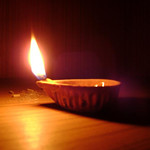Holiday season is upon us and for those of us in the northern hemisphere, its time to bring the winter clothes out of the closet. Time to stay warm and keep sickness at bay. Time to spend with family and friends and be thankful as ever for all that life has to offer us.
The shloka that I have chosen for today is another two liner. Its a verse praising Lord Vishnu, one of the Holy Trinity of Hinduism, the Life Giver or the Preserver.
Source: http://www.greenmesg.org/mantras_slokas/sri_vishnu-shuklambaradharam_vishnum.php
Sanskrit:
शुक्लाम् भरदरम विष्णुम् शशि वर्णम् चतुर्भुजम् ।
प्रसन्न वदनम् ध्यायेत् सर्व विघ्नोप शान्तये ॥
Kannada:
ಶುಕ್ಲಾಮ್ ಭರದರಮ್ ವಿಷ್ಣುಂ ಶಶಿ ವರ್ಣಮ್ ಚತುರ್ಭುಜಮ್ ।
ಪ್ರಸನ್ನ ವದನಮ್ ಧ್ಯಾಯೇತ್ ಸರ್ವ ವಿಘ್ನೋಪ ಶಾಂತಯೇ ।।
English:
shuklaam bharadaram vishNum shashi varNam chaturbhujam |
prasanna vadanam dhyayet sarva vighnopa shaantaye ||
Meaning:
(Let us meditate upon) Lord Ganesha, who is wearing white clothing, who is lustrous in appearance like the moon and one who has fours arms.(Let us meditate upon) him who has a compassionate and gracious face, to ward off all obstacles.
Notes:
The Sanskrit word, dhyayet, signifies the action of meditation (dhyaana) to be performed by the worshippers. Its an invitation that translates as 'let us all do dhyaana' upon Lord Vishnu who has all the characteristics that are then described in the shloka. The placement of the verb works very well in Sanskrit, but not so much in translation! This should be pretty easy as far as pronunciation goes, because there arent any multi-syllabic words.
Wishing you all a very happy and healthy holiday season!
The shloka that I have chosen for today is another two liner. Its a verse praising Lord Vishnu, one of the Holy Trinity of Hinduism, the Life Giver or the Preserver.
Source: http://www.greenmesg.org/mantras_slokas/sri_vishnu-shuklambaradharam_vishnum.php
Sanskrit:
शुक्लाम् भरदरम विष्णुम् शशि वर्णम् चतुर्भुजम् ।
प्रसन्न वदनम् ध्यायेत् सर्व विघ्नोप शान्तये ॥
Kannada:
ಶುಕ್ಲಾಮ್ ಭರದರಮ್ ವಿಷ್ಣುಂ ಶಶಿ ವರ್ಣಮ್ ಚತುರ್ಭುಜಮ್ ।
ಪ್ರಸನ್ನ ವದನಮ್ ಧ್ಯಾಯೇತ್ ಸರ್ವ ವಿಘ್ನೋಪ ಶಾಂತಯೇ ।।
English:
shuklaam bharadaram vishNum shashi varNam chaturbhujam |
prasanna vadanam dhyayet sarva vighnopa shaantaye ||
Meaning:
(Let us meditate upon) Lord Ganesha, who is wearing white clothing, who is lustrous in appearance like the moon and one who has fours arms.(Let us meditate upon) him who has a compassionate and gracious face, to ward off all obstacles.
Notes:
The Sanskrit word, dhyayet, signifies the action of meditation (dhyaana) to be performed by the worshippers. Its an invitation that translates as 'let us all do dhyaana' upon Lord Vishnu who has all the characteristics that are then described in the shloka. The placement of the verb works very well in Sanskrit, but not so much in translation! This should be pretty easy as far as pronunciation goes, because there arent any multi-syllabic words.
Wishing you all a very happy and healthy holiday season!



